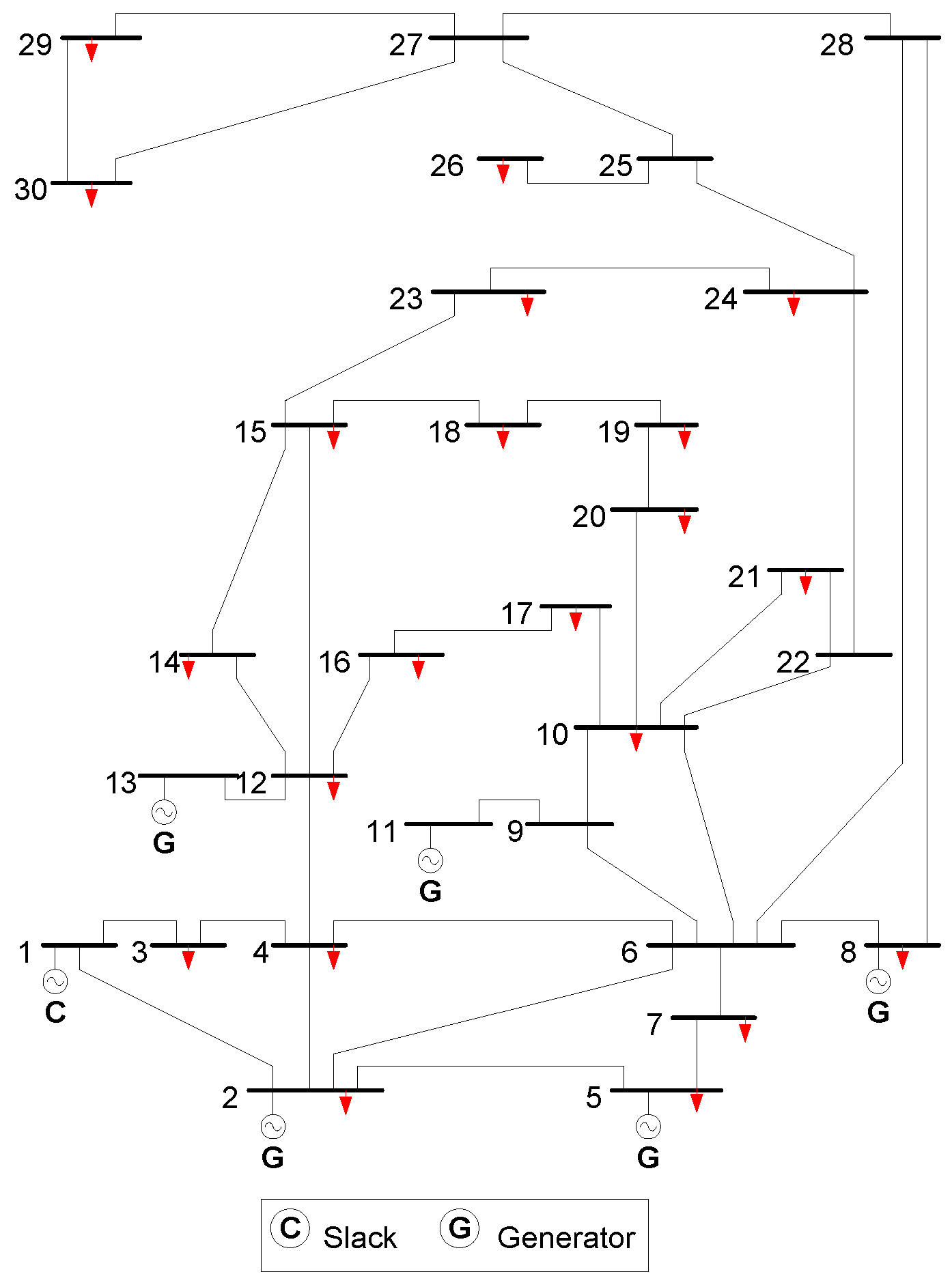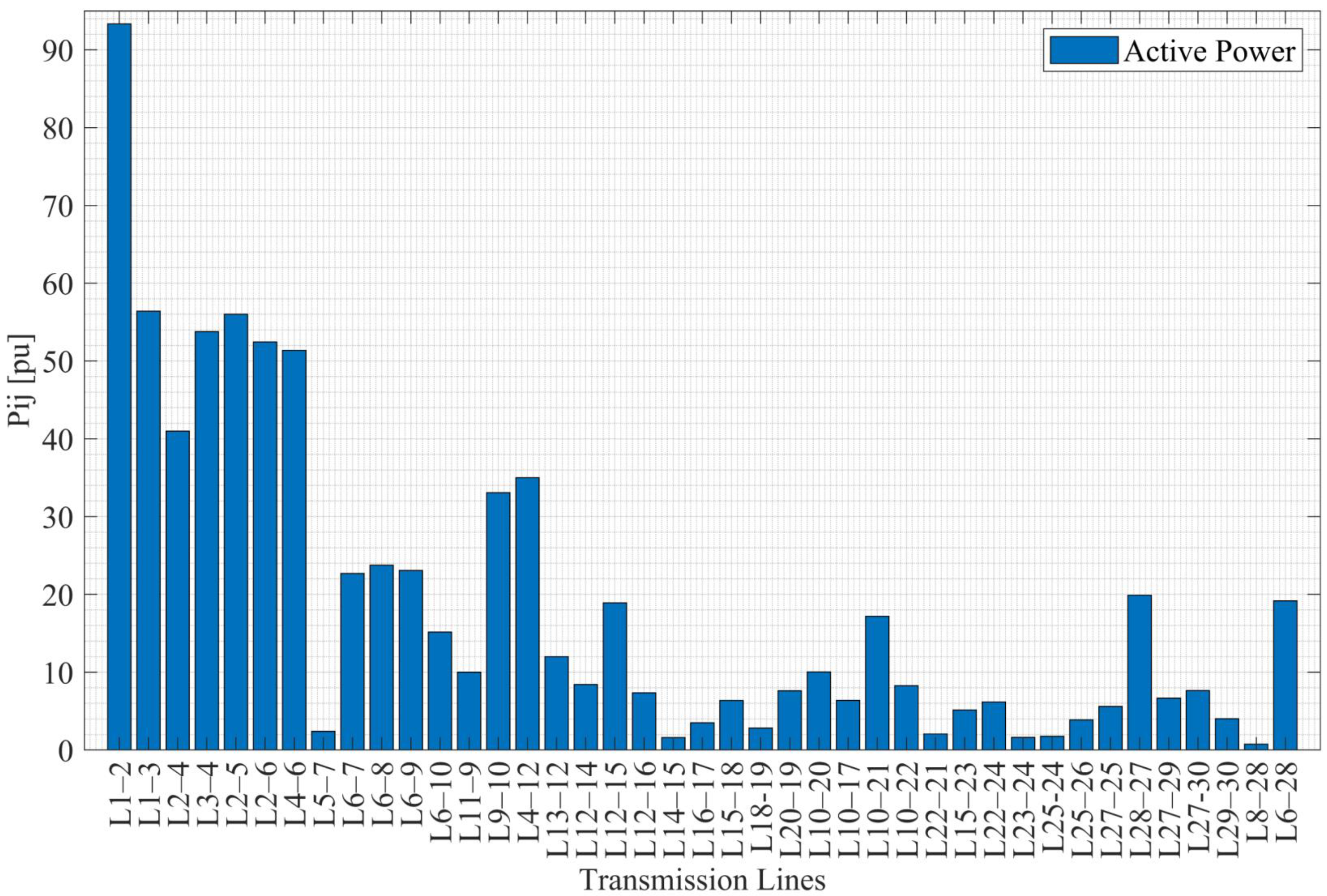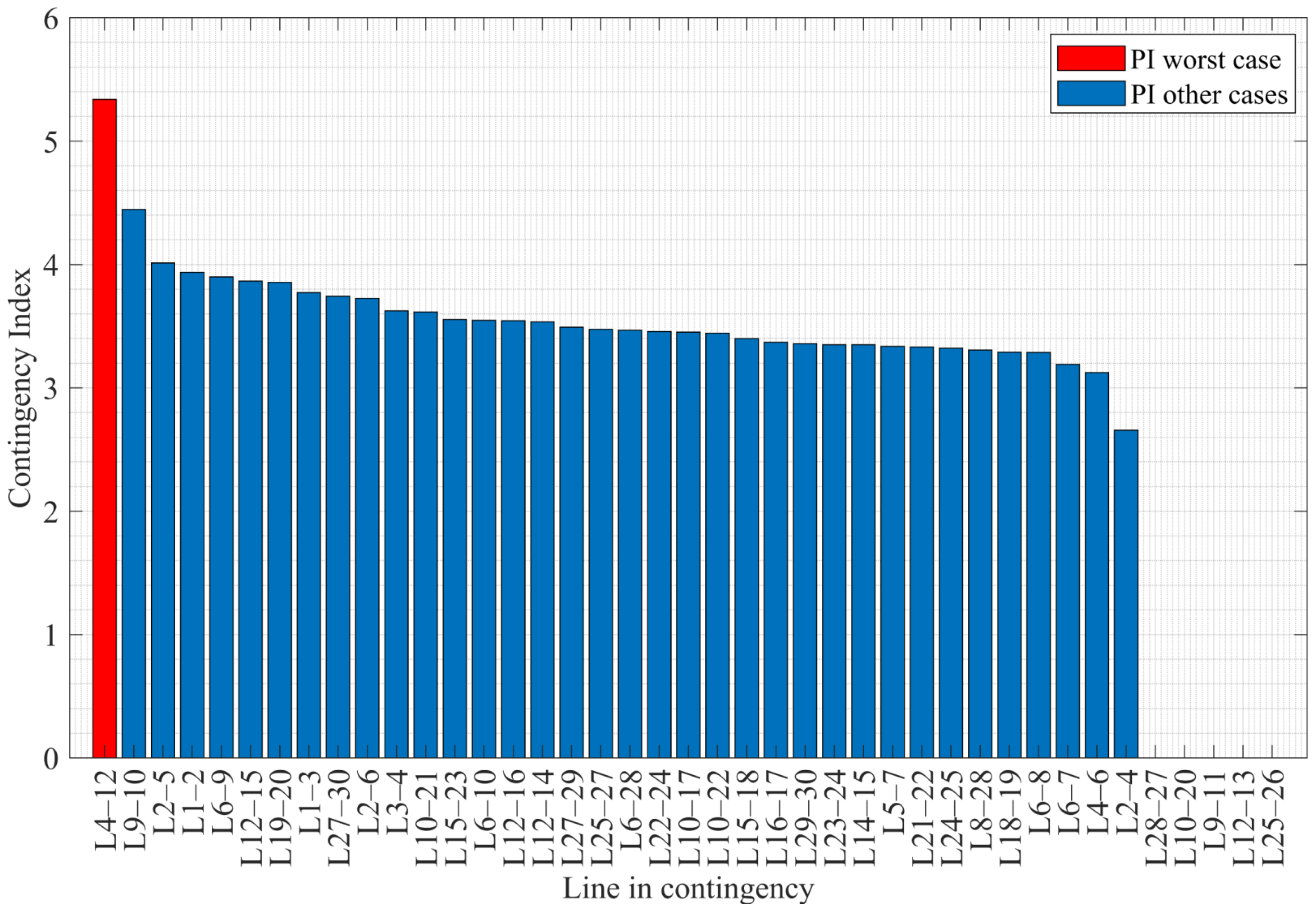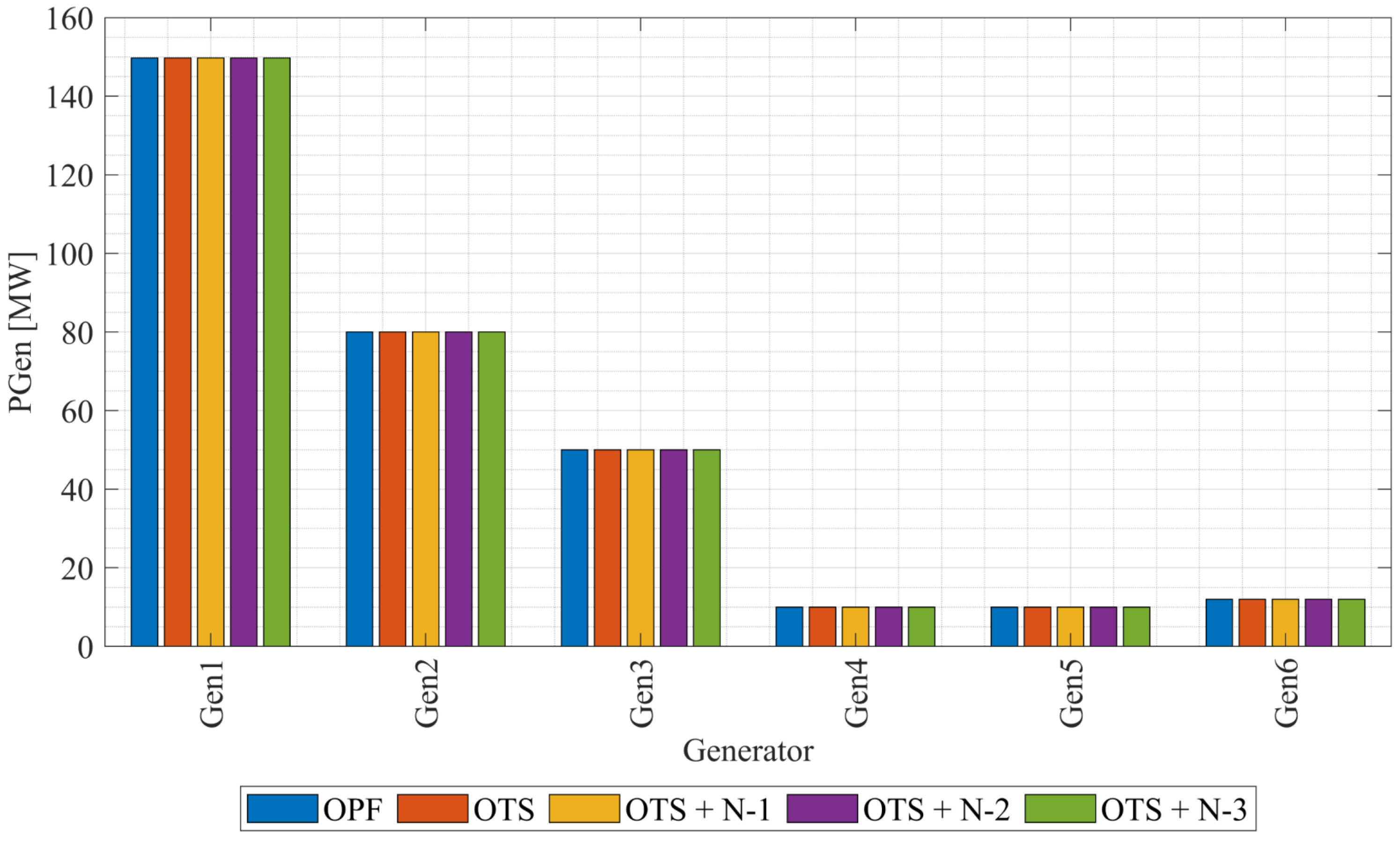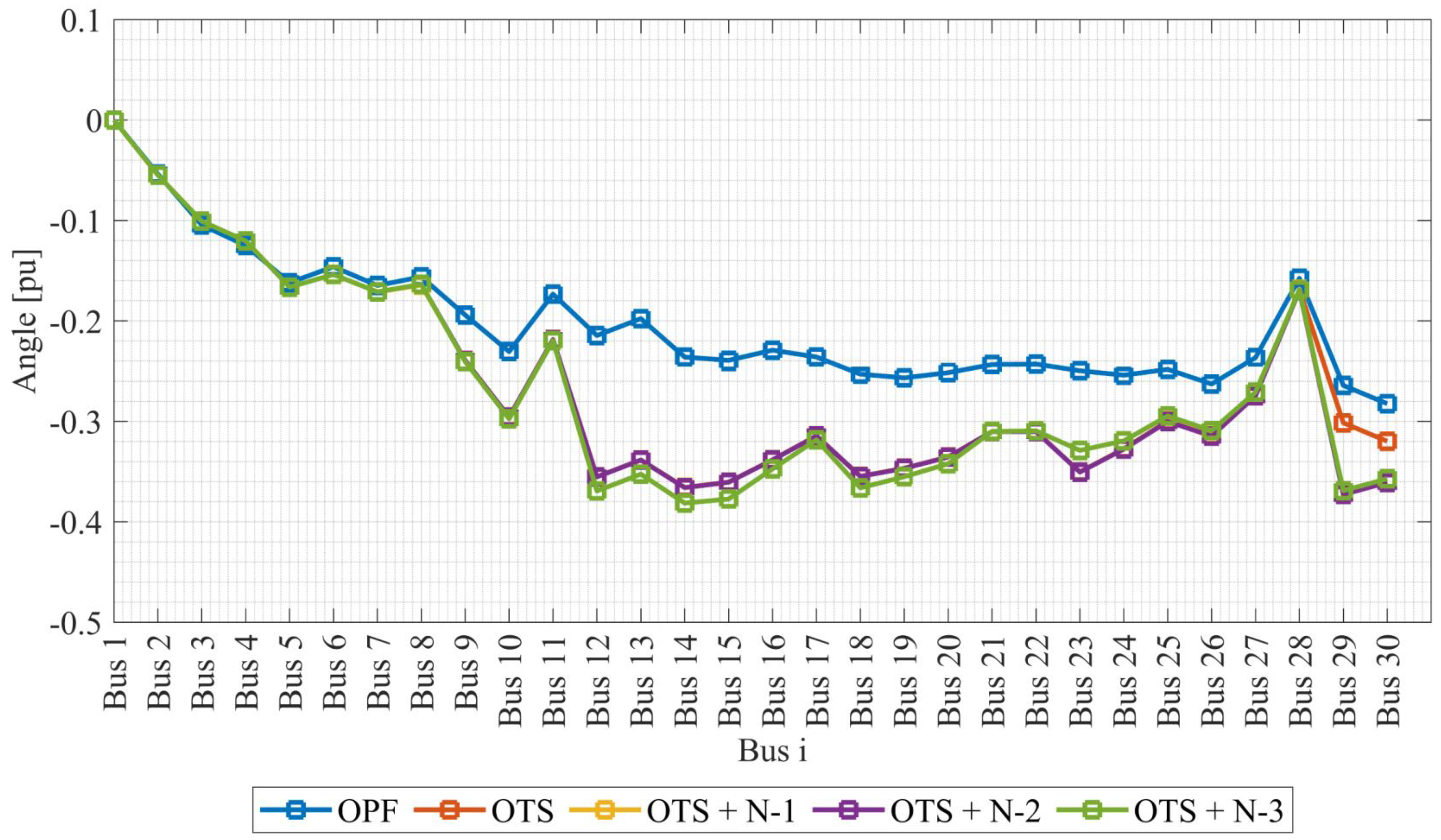1. Introduction
Advancements in technology have had a significant impact on the development of electrical power systems (EPS) management [
1]. Thanks to these advances, it is possible to monitor electrical networks with less effort [
2], as well as control the network through the transmission, reception, and processing of signals. However, finding a strategy that solves most of the planning problems seems to be an unattainable goal. One of the reasons for this problem is the static consideration of transmission elements.
Optimal switching of transmission lines (known as OTS) is a dynamic strategy that manages to optimize the power transmission and network design, reconfiguring the EPS topology [
3,
4]; a large part of the research carried out in relation to OTS is based on cost restrictions, congestion, and electrical losses [
5]. In previous works, OTS has been used to restore the operation of the EPS in the presence of contingencies and to generate the route for the re-entry of elements that go out of operation in an optimized order [
6,
7].
The importance of OTS in the study of resilient electrical systems [
8] should be noted; in other words, in systems that exhibit disconnections. After a contingency, the network topology is modified, therefore, the flows in the transmission lines change, which can cause damage to several of the elements. For this reason, the EPS must be able to overcome this eventuality and any subsequent contingency, otherwise, an “electrical blackout” could occur [
9]. Moreover, failures in the elements of a network can be caused by other instances, such as natural phenomena and errors in control devices [
10], which are also due to line overloads, and in exceptional cases, malicious attacks [
11].
In this framework, the algorithm proposed in [
12] collects loadability information on lines and bus voltage angles and allows economic dispatch (ED), which is developed through the optimal DC power flow strategy (OPF−DC). Subsequently, the impacts to the system caused by lines under contingencies N−1 were analyzed, combining OTS with OPF.
On the other hand, the research carried out in [
13] proposes an optimization model that aims to minimize the cost of operation and maximize the safety margin of the system. Similarly, the authors of [
14] propose a complex optimization algorithm known as MISOCP.
Thus, transmission lines are fundamental elements in an EPS [
15]. Currently, they are the main objectives of the study, especially lines that cover long distances and have a high power transfer capacity. In addition, there is a probability that they present unexpected emergencies; due to overload or low voltage levels, this condition increases the risk of failures and makes them vulnerable to intentional attacks.
Based on the above, the study presented in [
16] describes a corrective switching method as a control tool for a line. The research proposes a multi-objective optimization algorithm with six opposing objective functions, which cover aspects, such as economy, security, and reliability. Indeed, the authors recommend establishing emergency operation plans and, thus, counteract possible eventualities in the electrical system. The same approach is presented in [
17]. On the other hand, some authors propose optimization models based on mixed-integer linear programming (MILP) and others use methods to accelerate the exploration of ideal solutions, such as the Benders decomposition used in [
18,
19], to analyze the use of multi-circuits in transmission lines with different voltage levels, allowing the same route to establish other energy uses. Still, it must be considered that if something happens in the said link, the EPS will be seriously affected.
Moreover, transmission lines that cover large distances are exposed to malicious attacks [
20]. The vulnerability of EPS to deliberate disconnections was assessed using a methodology that analyzes security. Implementing appropriate energy management in electricity distribution companies has significantly improved the quality of service provided to customers. Implementing such strategies can result in a loss of security due to malicious attacks. Research, such as [
21], has focused on simulating and studying cyber-physical attacks against power grids.
Cybernetic infrastructure integration into smart grids increases the attack capacity due to the diversity and quantity of available tools [
22]. Generation adjustment, load shedding, and optimal switching of lines are alternatives to facing intentional attacks that put demand at risk.
In this sense, the information provided in [
2] is based on results obtained in the face of alterations caused by cyber-attacks in different countries; these not only affect the operation of the system, but there are also cases in which the infrastructure suffers considerable damage; in other cases, energy theft is identified despite having AMI. For this reason, it is of the utmost importance to analyze the cybernetic vulnerability of the network in its entire context and, thus, propose solutions to protect it against cybernetic adversaries.
In this topic, in [
23], the researchers propose a multi-agent system capable of evaluating the energy system’s vulnerability while monitoring the protection device’s hidden errors and providing control actions to avoid events of cascading sequences. In addition, in [
24], the authors determine that the security of critical system components must be observed to deal with infrastructure damage, whether due to natural damage or intentional attacks. The problem–solution approach is based on multi-objective optimization with multi-decision criteria.
Even more, in [
21], criteria for coordinated cyber-physical attacks against electrical power systems are formulated; in addition, they detailed that an attack is produced by the injection of false data—known as FDIA—against the corrective action schemes available for the EPS, which can lead to power outages. It also appears that the attack may be aimed at manipulating PMU data. To simulate the problem, the author proposes the placement of a process called semi-Markov that allows the integration of exponential and non-exponential probability distributions with the aim of discovering the nature of possible intentional attacks.
Likewise, the research in [
25] proposes the intentional attack as a maximum–minimum problem, where the terrorist maximizes the damage he will cause. At the same time, the system operator seeks to minimize it. In [
11], the analysis described above is deepened, transforming existing nonlinear expressions into linear constraints. Thus, the researchers manage to convert a maximum–minimum problem into a single-level maximum–maximum problem, which is solved by applying the Bender’s decomposition and mixed-integer linear programming.
In this exact order of ideas, the research presented in [
26] addresses the vulnerability analysis of the electrical network under terrorist threats. In this problem, a bi-level nonlinear program is formulated. At the higher level, the terrorist attacker will always maximize the damage he can cause; that is, a terrorist will seek to maximize the loss of the load on the system. Subsequently, the model at a lower level states that the operations of the systems should minimize the possible damage to the system and what could occur in the network; the objective is to maintain the optimal functioning of the EPS. The study’s primary objective focuses on analyzing the possible corrective actions that can be applied in the face of an attack. One of them is the possibility that the system operator can modify the topology of the EPS, keeping the power supply on the load. It also clarifies that the model has non-convex or linear results that can be interpreted; for this reason, two-level programming cannot be interpreted in an equivalent result of optimization at one level, the author proposes another model related to Bender’s decomposition.
For their part, the authors in [
27] focused on developing a novel key pre-distribution scheme to reduce the severity of cyber-attacks on SCADA systems by proposing a matrix that supports device connections and key upgrades with low communication costs.
Moreover, the authors in [
22] focus on real-time security, consisting of two main parts: contingency analysis and network monitoring. The system’s physical characteristics are considered in greater depth than the cryptographic details. In addition, malicious behavior and component errors are simulated; then, possible effects that may occur in the system are analyzed; finally, algorithms are proposed to allow against subtracting the attacks.
In [
28], a cascade interrupt model is used to simulate the behavior of the system before contingencies, where the attacker uses Q-learning models to improve the damage of the attack and, thus, produce errors in the system with less effort, The algorithm is tested on three IEEE systems, demonstrating the learning capacity and the effectiveness of the vulnerability analysis achieved by the Q-learning model, thanks to the identification of critical components in a potential sequential attack scheme.
The purpose of this research is to vary the grid’s topology in the face of N−1 contingencies and, thus, maintain the quality and reliability of the system. To achieve this, an algorithm based on OTS is developed to determine which lines must be switched in the event of scheduled or unexpected disconnections. From the literature review and according to the needs of the present research, only OPF−DC will be used as a basis, thus reducing the complexity of the optimization problem and the execution time of the solution.
This research is organized into five sections that are described below: the first section deals with the research works that are concurrent among the authors who focused their analyses on topics related to this article; in the second section, the methods and mathematical models for solving the problem of intentional attacks are presented; in the third section, the problem statement is presented in detail; in the fourth section, we present the analysis of results achieved after the simulations; and finally, in the fifth section, the conclusions reached in this study are stated.
3. Problem Formulation
This research proposes an optimal operation model after intentional attacks where switching of transmission systems is considered, which will allow analyzing the effects of intentional attacks on the power system’s operation and choosing which transmission lines can be switched after an intentional contingency.
Switching of transmission lines is a strategy that allows analyzing the electrical system from a dynamic perspective. By modifying the topology of the network, the flows that circulate through the lines are altered, causing inconveniences to the operator. Considering that the disconnection of EPS equipment is a common situation, and occurs for different reasons, it is essential to analyze which elements will be highly affected by failures that may occur in the SEP. Through the ranking of contingencies, it is possible to determine the disconnections that cause the most damage to the system.
The optimal flow of DC power, being a linear analysis method, allows for preserving the system’s safety in operation and finds an economic operation that is feasible by minimizing an objective function, such as minimization of fuel cost, VAR planning, and minimization of losses. It is also possible to modify the control systems to account for equality and inequality constraints used to model a balance of power constraints and performance constraints.
The OTS model also serves as a management tool to change the EPS topology as it transports power more efficiently through the power transmission lines.
The objective is to determine the behavior of the EPS, considering the OTS application up to a contingency of N−1. In this way, the aim is to determine if the system can withstand an additional contingency (N−1)−1, and to verify if it is possible to maintain the operation of the system under operation criteria, such as maintaining the system within voltage margins, keeping the angle within deviation margins, and avoiding overloading of transmission lines due to changes in flow resulting from line changes. Additionally, a contingency analysis is performed to identify the vulnerable lines of the system.
On the other hand, the OTS criterion must be applied to analyze the system’s response to line switching. To reduce the complexity and contrast the results of the algorithm, OTS is proposed, on the one hand, and OTS N−1, on the other. In this way, comparing the results of each alternative, the benefits of each one will be noted. It should be noted that both strategies use OPF−DC as a tool for power flow, which provides information on line loads, bus voltage angles, and electricity production costs.
Finally, line switching is analyzed in the presence of a possible contingency case, which will be determined by the contingency ranking. For the optimal operation model, the IEEE 30−bus system was considered, which was designed for the analysis of operation, taking into account switching in transmission systems. Among the relevant characteristics of the IEEE 30−bus system, the system has 30 bars, 41 lines, 21 loads, and 6 generators, as can be seen in
Appendix A.
With the previous information, one intentional attack was carried out randomly, which represents an N−1 contingency, i.e., an attack that will affect the operation of the system; for this, the contingency index is obtained, which is represented as a scalar value according to Equation (
18).
Intentional attacks are determined where the lines that are in operation will have a value of 1 and those that are out of service will have a value of 0. The value of the voltage considered for this initial analysis is 1 [pu] using OPF−DC and by analyzing the operating power of the entire system.
The results include information about the power in nodes, generated power, and delta angle, where it can be seen to what extent the values are affected by intentional attacks and which lines can keep the EPS operational, the proposed methodology is shown in Algorithm 1.
| Algorithm 1 Topology reconfiguration based on OTS-DC. |
- Step: 1
Input data EPS parameter setting Lines: and Generators: and Loads: - Step: 2
Critical event determination for line 1: end N−1 contingency if OPF−DC converges else discard the event end if end for - Step: 3
Topology reconfiguration Randomly apply intentional attack for each PI if OTS converges else discard new topology end if end for - Step: 4
Show results
|
4. Analysis of the Results
The algorithm simulation was developed for the case study to determine the topology of the system that allows for maintaining the power supply after malicious attacks; see Algorithm 1. For this purpose, a list of the most harmful contingencies for the EPS must be made, which was developed in MATLAB R2018b. Subsequently, OTS was performed in the GAMS environment, taking into consideration the contingencies described above. This simulation ran on a computer with the following descriptions: CPU i7-4500, clock frequency 2.4 GHz, 8 GB of RAM, and Windows 8.
The test was performed on an IEEE 30−bus system as shown in
Figure A1; the design of the network allowed making structural changes to it. Furthermore, bus 1 was assumed to be the oscillating bus of the SEP.
The pre-contingency data for both lines and bars of the system can be seen in
Table A1,
Table A2, and
Table A3, respectively.
Once the simulation was carried out in the system indicated above, the particularities that the EPS presented in the post-contingency conditions could be evidenced, where condition N−1 was evaluated in each line. Once the data were obtained, they were imported into MATLAB; subsequently, the performance index or PI factor was determined, which weighed each contingency’s impact on the system.
System in Pre-Contingency Conditions
For the initial analysis, the active power delivered by each generator was established to cover all of the demands needed by the system at the lowest costs, as shown in
Table 1.
As can be seen in
Figure 1, the power flow carried out by the transmission lines of the system is in a stable state, and the PI values are shown in
Table 2.
In
Figure 2, the transmission lines are classified from greater to lesser impacts, where the highest value produces greater severity in the system in the event of an intentional attack.
In
Table A3, there are 41 operating lines; however, they are according to what was proposed for this analysis where the lines whose PI values are above 4.5 are considered. The results presented in
Figure 1 show the power flow in each power transmission line before applying the switching action on the EPS. Lines L28−27, L10−20, L9−11, L12−13, and L25−26 needed special consideration because the optimal transmission switching model did not allow the EPS to be restored in the event of an intentional attack, resulting in losses and operating costs; see
Figure 2. For this case, re-powering must be planned, or, the need to implement distributed generation that allows optimal transmission switching in these nodes can be considered.
Through OPF−DC, the power flow analysis was performed for the base case. The results compare the system’s response to the contingencies considered for this study. In addition, these results show that some lines are underutilized, as is the case with lines L5−7 and L6−7, whose loadabilities are very low, i.e., 3.4% and 17.4%, respectively. It is essential to highlight that L9−11 does not transport flow, due to the lack of power demand in bus 11. On the other hand, L1−2 is at its operating limit with a load capacity of approximately 95.38%.
Subsequently, the OTS methodology is applied to the base case, resulting in the switching of five transmission lines. The significance of this technique is highlighted as it optimizes the utilization of the system’s physical resources.
In the case of L28−27, it causes the loss of the generation units that are connected to busbars 1 and 3. The aforementioned contingency can be considered the most important in terms of classifying cases of force majeure within the ranking of contingencies. On the other hand, the disconnection of lines L10−20 and L25−26 causes the disconnection of the loads connected to busbars 20 and 26. Lastly, lines L9−11 and L12−13 cause the disconnection of generation units, specifically Gen5 and Gen6 from bars 11 and 13, respectively.
The lines that deserve planning and expansion are discarded; the ranking of contingencies is carried out only with the lines where optimal transmission switching can be applied, as shown in
Figure 3.
Excluding the unfeasible cases, the most critical contingency under the contingency ranking analysis in the IEEE 30−bus system would be the contingency involving lines L4−12 and L9−10, which cause more significant inconveniences than the other failures.
Although there are cases that generate worse conditions in the system, these are not considered because the OTS strategy does not provide a solution (performance index = 0), e.g., contingencies that cause the non-operation of generators or the formation of islands. Among the list of contingencies to be considered for the OTS simulation, the disconnection of L4−12 is deemed to be the most severe. Additionally, the loss of L1−2 is assumed, as it carries the highest power flow.
The EPS analyzed in this article requires approximately 310 MW for its optimal performance; each generator in the different scenarios contributes an amount of power that provides energy; on the other hand, in other scenarios,
Figure 4 shows the power dispatch of each generator. The generation cost is the same in all scenarios and amounts to 587.98
$/h.
Meanwhile, the voltage angle variation when applying OPF−DC and OTS is observed in
Figure 5, where the voltage angle in bus 3 presents the most significant change (−0.236 to −0.381).
Now, when considering the contingency of L4−12, several vital events exist to analyze. On the one hand, the optimal switching model proposes three line disconnections, without considering the contingency line. For this reason, a total of four lines will be disconnected from the EPS, causing an increase in the power flow in the lines that share a common busbar with the disconnected lines.
L16−17 had a loadability of 93.50%, close to its operating limits; this value is well above the 29.50% loadability obtained in the pre-contingency state. A particular case occurs in L2-6, as can be seen in
Figure 6; it was considered switched in OTSDC; however, due to the contingency of L4−12, it is included in the network. As a consequence, its loadability increases to 86.38%.
On the other hand, at this point, it is believed that the voltage angles in all of the simulated scenarios are the same, with a few exceptions. In addition, there is a considerable increase in flow in most of the lines, as is the case with L4−6. However, some lines maintain a constant power flow in all study scenarios, as with L6−8, L9−11, L12−13, and L27−30.
Likewise, the switching of L27−29 deserves special attention due to its presence in all analyzed study cases; therefore, it can be excluded without fear of severe repercussions for the system.
It should be noted that the scenario with L1−2 in contingency causes a load capacity of 100% of L12−15; thus, after a specific time, the line will be disconnected; consequently, the simple contingency problem will become N−2 and, subsequently, a possible cascade failure will arise. However, this event is not emphasized because it transcends the objective of the study.
5. Conclusions
The proposed methodology focuses on the behavior of power systems under intentional attacks. The methodology uses optimal DC power flows and optimal switching of transmission lines to quantify the active power flows through the lines and the voltage angles at the nodes. Based on these two parameters, possible collapses can be verified based on the contingency index. This allows the ordering of contingencies from the one that has the most significant impact to the least important.
It can be observed how the loadabilities of the lines are affected as the number of elements that go out of operation increases, and this is where the OTS criteria, together with the contingency index, become vital. Since it is an optimization function, it respects all the restrictions that allow the objective function to be fulfilled, and possible line disconnections are determined that will enable the EPS to operate within its safety limits. Thus, the restoration of the EPS operation generates alternatives that involve disconnecting some additional lines.
The proposed methodology prevents loads from being disconnected or, in other words, electricity rationing is generated for end users, optimizing technical resources; for example, generators dispatch the same amount of energy regardless of the number of lines that are disconnected and at the same time the contingency selection criteria reject situations that this methodology cannot solve. For this reason, in the event of the formation of islands or the disconnection of generators, future research must apply complementary techniques that avoid these events.
Finally, one of the possible extra applications of the proposed methodology is that power system operators can identify which elements of the EPS require the most attention concerning possible contingencies and, thus, be able to determine improvement plans or EPS expansions.
One of the main weaknesses of the proposed methodology is that when using the OPF−DC model as a basis, there are event exceptions that cannot be considered due to the fact that an excess of demand is generated in comparison to the generation; thus, lines L28−27, L10−20, L9−11, L12−13, and L25−26 were not considered as contingency possibilities. For the model to work with these types of cases, it should be hybridized with one that performs expansion planning or EPS improvement.
